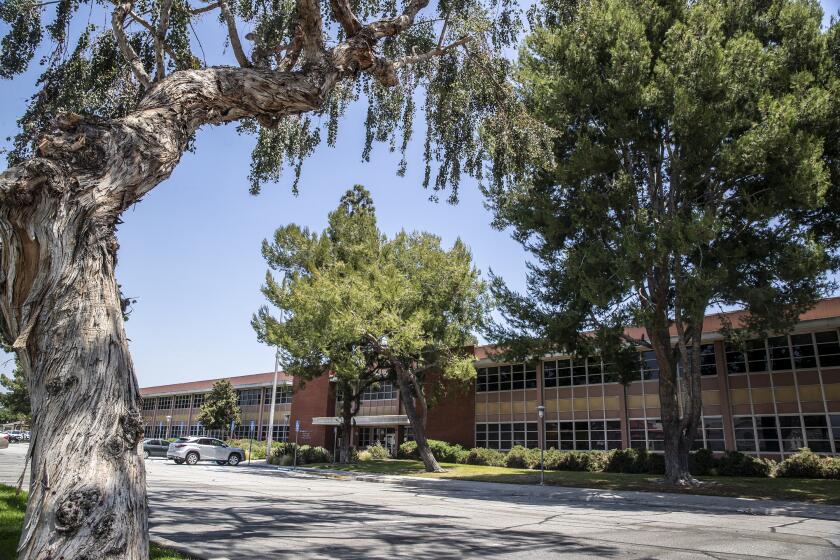Parker Center Emblematic of LAPD’s Dire Needs
- Share via
LOS ANGELES — During the tense hours after the Northridge earthquake, Los Angeles police officials rushed to Parker Center, only to find the fabled downtown LAPD headquarters in disarray. Power was out in most of the building. Stairways were flooded because shoddy plumbing had failed. With power and telephones out, the department had lost contact with officers in the field.
The 1994 earthquake made apparent what police brass had been saying for some time--Parker Center was a deteriorating, ill-equipped fortress at the center of an embattled department.
LAPD officials this week said little has changed since the earthquake. A report obtained by The Times earlier in the week, compiled by a high-powered group of consultants and city leaders who assessed LAPD facilities, concurs with this assessment. The report, which suggests replacing a number of division stations and constructing a few additional ones, recommends demolishing Parker Center.
The building has long been emblematic of the Los Angeles Police Department--from its heroics during natural disasters to the controversial police culture embodied by its namesake. But now it has come to represent yet another pressing issue for the department: the deterioration of the LAPD’s aging facilities.
Parker Center, say the police officers who work there, is a facility that is too small, too old, too overcrowded and too far gone to be salvaged. The plumbing leaks. The floors sag. The paint is peeling. Much of the equipment does not work.
“Some of the units here look exactly the same, with exactly the same furniture, as when Jack Webb was filming ‘Dragnet’--and that was almost 40 years ago,” said Lt. Anthony Alba, who heads the press relations office, which is based at Parker Center. “It’s downright embarrassing.”
Parker Center’s eight stories and 260,000 square feet have never been enough for the department. Police officials now need more than twice as much space as the building provides, Sgt. Stephany Payne said.
*
The headquarters--nicknamed the Glass House by prisoners who were housed there--has been maligned since the day it opened in 1955. The Los Angeles Police Department grew quite a bit between the time the building was designed and when it finally opened, said Jake Jacoby, a police reporter who began working in the headquarters’ press room in 1955.
“Almost from the day it opened its doors, police officials were complaining there wasn’t enough room,” Jacoby recalled. “Every year it got more and more crowded.”
On Wednesday afternoon in Parker Center’s basement, rain flooded the Property Division. Workmen were pushing mops and vacuums, trying to keep the water away from the racks where evidence was stored.
In another section of the division, there is a large red light on the ceiling. About once a month, when the plumbing backs up and begins leaking into the basement, the light flashes and clerks scurry about, covering the computers and hauling out buckets to catch the water.
“It gets so bad, it sometimes knocks the panels out of our ceilings,” said Jean Vermeer, a senior property officer. “Sometimes it comes down in a drip and sometimes in a stream. And then it’s time for some heavy-duty cleanup.”
In the division’s storage room, large pieces of plastic sheeting protect pistols, rifles and other evidence because of the leaky ceilings. There are jagged holes in the ceilings and enormous mousetraps in the corners of the room.
On the 5th floor, where job candidates are interviewed, it is so crowded--and there is so little room in the lobby--that 20 to 30 people sometimes line the hallway. In a dank stairwell nearby, a small desk and a chair are jammed in a corner; this is where candidates are interviewed when all the desks in the office are occupied.
“For some people going through the hiring process, this is their first impression of the LAPD,” said Payne, pointing to the desk and chair in the stairwell. “You got to wonder what they’re thinking.”
Down the hall, in the Personnel Division, employees had to haul 10,000 personnel records to the basement because the weight of the folders and the file cabinets was causing the floor to sag.
While City Hall, with its distinctive Art Deco design, symbolizes the City of Angels, Parker Center is a bland structure on North Los Angeles Street. The boxy, glass-and-steel tower looks--from a distance--like an enormous refrigerator.
The building was originally called the Police Administration Building. It was renamed Parker Center in 1967, in honor of William H. Parker, who served as LAPD chief from 1950 to 1966. Parker is credited with transforming the LAPD from a corrupt, scandal-ridden department to a national model of a professional police organization.
Parker created an aggressive, efficient, paramilitary organization. He rooted out corruption and emphasized technology and science to fight crime. But what he gained in efficiency, he lost in community relations.
When the LAPD’s headquarters was named after Parker, many in the city’s minority communities were deeply offended. Parker was reviled in many of the city’s poorest neighborhoods because of the style of policing he devised for the LAPD.
Los Angeles traditionally has had one of the smallest police departments, per capita, in the nation. As a result, Parker believed it was important to discourage criminal activity before it happened. He called this “proactive policing.”
While Parker regarded this style of policing as aggressive, many residents in black and Latino neighborhoods, who bore the brunt of “proactive policing,” considered it harassment. Residents complained that this new LAPD ethos made them feel as if they were prisoners in their own communities.
“It’s a tough place to work and you face a lot of obstacles,” said Payne, who works on the sixth floor. “We all just try to keep our mind on our jobs . . . and ignore the overcrowding, the holes in the ceiling, the leaks and the mousetraps.”
Times staff writer Jim Newton contributed to this story.
More to Read
Sign up for Essential California
The most important California stories and recommendations in your inbox every morning.
You may occasionally receive promotional content from the Los Angeles Times.










